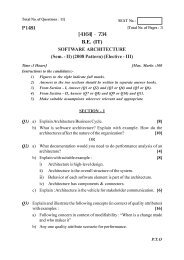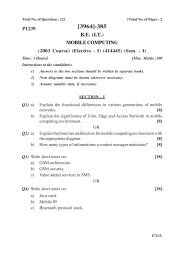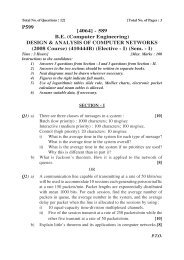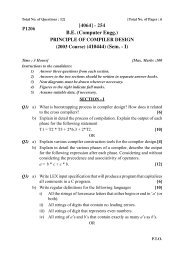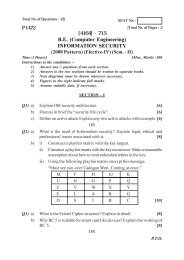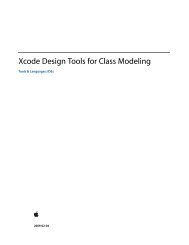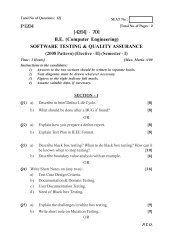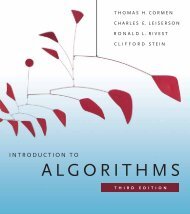Cloud Computing and SOA Convergence in Your Enterprise: A Step ...
Cloud Computing and SOA Convergence in Your Enterprise: A Step ...
Cloud Computing and SOA Convergence in Your Enterprise: A Step ...
Create successful ePaper yourself
Turn your PDF publications into a flip-book with our unique Google optimized e-Paper software.
Def<strong>in</strong><strong>in</strong>g the Information Model 91<br />
ous <strong>in</strong>formation systems, many different terms are used for attributes. The<br />
notion of ontologies, <strong>in</strong> this scenario, allows us to determ<strong>in</strong>e whether entities<br />
from different applications <strong>and</strong> databases are the same or noncrucial to fus<strong>in</strong>g<br />
<strong>in</strong>formation for the purposes of our data analysis.<br />
Exist<strong>in</strong>g Web-Based St<strong>and</strong>ards <strong>and</strong> Ontologies<br />
The use of languages for ontology is beg<strong>in</strong>n<strong>in</strong>g to appear, built on reason<strong>in</strong>g<br />
techniques that provide for the development of special-purpose reason<strong>in</strong>g services.<br />
In fact, the W3C created a Web st<strong>and</strong>ard for an ontology language as<br />
part of its effort to def<strong>in</strong>e semantic st<strong>and</strong>ards for the Web. The Semantic Web<br />
is the abstract representation of data on the World Wide Web based on the Resource<br />
Description Framework (RDF) <strong>and</strong> other st<strong>and</strong>ards still to be def<strong>in</strong>ed.<br />
It is be<strong>in</strong>g developed by the W3C <strong>in</strong> collaboration with a large number of researchers<br />
<strong>and</strong> <strong>in</strong>dustrial partners.<br />
In order for the Semantic Web to function, computers must have access to<br />
structured collections of <strong>in</strong>formation <strong>and</strong> sets of <strong>in</strong>ference rules that they can use<br />
to conduct automated reason<strong>in</strong>g. This notion is known as knowledge representation.<br />
To this end, <strong>and</strong> <strong>in</strong> the doma<strong>in</strong> of the World Wide Web, computers will<br />
f<strong>in</strong>d the mean<strong>in</strong>g of semantic data by follow<strong>in</strong>g hyperl<strong>in</strong>ks to def<strong>in</strong>itions of key<br />
terms <strong>and</strong> rules for logical reason<strong>in</strong>g about data. The result<strong>in</strong>g <strong>in</strong>frastructure will<br />
spur the development of automated Web Services such as highly functional<br />
agents. What is important here is that the work now be<strong>in</strong>g driven by the W3C as<br />
a way to manage semantics on the Web is applicable, at least at the component<br />
level, to the world of application <strong>in</strong>tegration, much like XML <strong>and</strong> Web Services.<br />
An example of the W3C contribution to the use of ontologies is the Web<br />
Ontology Language. OWL is a semantic markup language for publish<strong>in</strong>g <strong>and</strong><br />
shar<strong>in</strong>g ontologies on the World Wide Web. OWL is derived from the<br />
DAML+OIL Web Ontology Language <strong>and</strong> builds on the RDF. OWL assigns a<br />
specific mean<strong>in</strong>g to certa<strong>in</strong> RDF triples. The future Formal Specification, now<br />
<strong>in</strong> development at the W3C, specifies exactly which triples are assigned a specific<br />
mean<strong>in</strong>g <strong>and</strong> offers a def<strong>in</strong>ition of the mean<strong>in</strong>g. OWL provides a semantic<br />
<strong>in</strong>terpretation only for those parts of an RDF graph that <strong>in</strong>stantiate the<br />
schema. Any additional RDF statements result<strong>in</strong>g <strong>in</strong> additional RDF triples are<br />
allowed, but OWL is silent on the semantic consequences of such additional<br />
cont<strong>in</strong>ued



